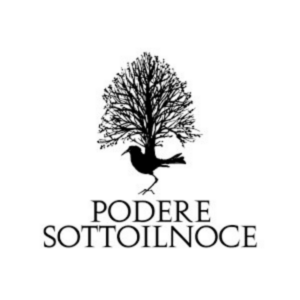Podere Sottoilnoce

Max Brondolo
About
Owner & winemaker: Max Brondolo
Vineyards: 6.5ha across four parcels, all estate-owned
Vineyard management: Certified organic, practicing biodynamic since 2016
Soils: Predominantly clay
Grapes grown: Lambrusco Grasparossa, Lambrusco di Sorbara, Lambrusco del Pellegrino, Uva Tosca, Trebbiano Modenese, Trebbiano di Spagna, and others
Annual production: 30,000 bottles
Quick facts:
- Podere Sottoilnoce produces traditional bottle-fermented Lambrusco from over a dozen nearly forgotten grape varieties.
- “What I learned through this very intense eight years of winemaking is not only how to make wine, but also that grape diversity is a treasure and sometimes gives you solutions.” – Max Brondolo
Modena has been a center of grape-growing and winemaking since before the Roman Empire, and sparkling wine has been made there since the 1500s, well before champagne. However, when most people think of Lambrusco from Modena, their perceptions are colored by the industrialized winemaking that has dominated the region since the mid-20th century: sweet fizzy red wines, the “Italian Coca-Cola.”
Within the last two decades, a small handful of winemakers have looked past this reputation to the style of wines that were made in the region prior to industrialization: bottle-fermented, made with dozens of nearly forgotten grape varieties, from the more interesting vineyard sites. Max Brondolo was one of them. He fell in love with wine as child, working along his grandfather, who was a winemaker in Piedmont. “I did the harvest with him until I was ten years old,” Max tells us. “I have a lot of those physical memories in terms of colors, noises, smells.” The family property was sold long ago, but when Max had the opportunity to purchase a small vineyard in Modena in 2016, he jumped at the chance to reconnect with his roots. Initially skeptical of the underrated region, he was won over once he tasted the pre-industrial style of Lambrusco. “I don’t think right now there is a better place than the area of Modena to make wine,” he asserts.
The treasure of Modena is its incredible diversity of native grape varieties. “Lambrusco” is not one grape but rather a family of grape varieties, and in the 1880s, more than 100 different types were grown. Today, nearly all plantings are dominated by only three or four varieties. Max grows sixteen different varieties at Podere Sottoilnoce, several of which were nearly extinct and have been preserved in collaboration with the University of Bologna. “What I learned through this very intense eight years of winemaking is not only how to make wine, but also that grape diversity is a treasure and sometimes gives you solutions,” Max explains. His vineyard sites are found in the hills in the southern part of Modena, where the soil is rich fertile clay, favoring the production of more powerful, fruit-forward, deeper wines. In order to make balanced wines with freshness and drinkability, he thoughtfully takes advantage of the different characteristics of the grape varieties in the blend: for example, pairing the fruit and fleshiness of Lambrusco Grasparossa with the high acidity of Sorbara and Uva Tosca.
The wines are made the way Lambrusco was made hundreds of years ago, via what’s known as the Emilia method. Primary fermentation takes place spontaneously in concrete tanks, then the wine is bottled in the spring for the second fermentation. Instead of adding sugar and commercial yeast like in champagne, the second fermentation is kickstarted with the addition of frozen must from the same vintage. Once temperatures begin to rise, the fermentation restarts naturally from the native yeasts still present in the juice. The resulting sparkling wine has around 2-2.2 bars of pressure, and the wine is not disgorged. “Not disgorging means that the wines will have an infinite life,” Max tells us. “Disgorgement is the first moment where a bottle-fermented wine will start declining. The wine will also keep changing and evolving as long as it’s on the lees. It’s like having a living being inside the bottle. It’ll always be alive when you open it and it’s always changing. It will surprise you.”

